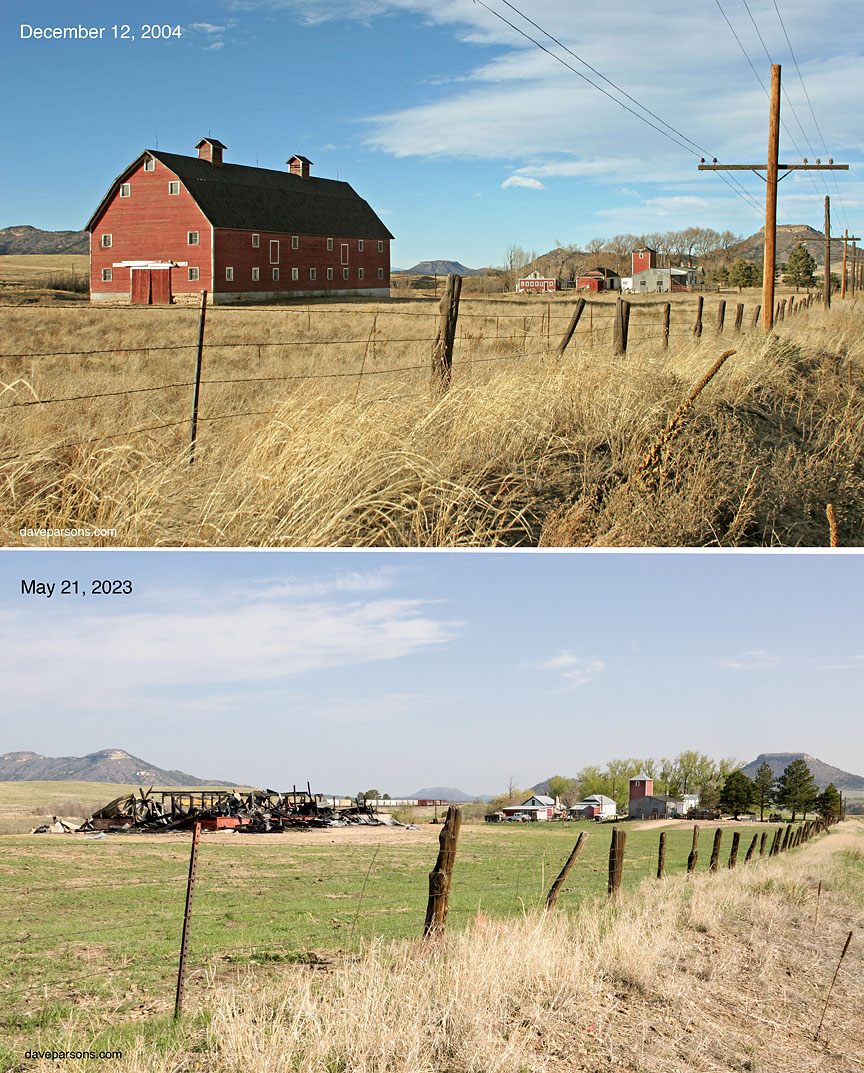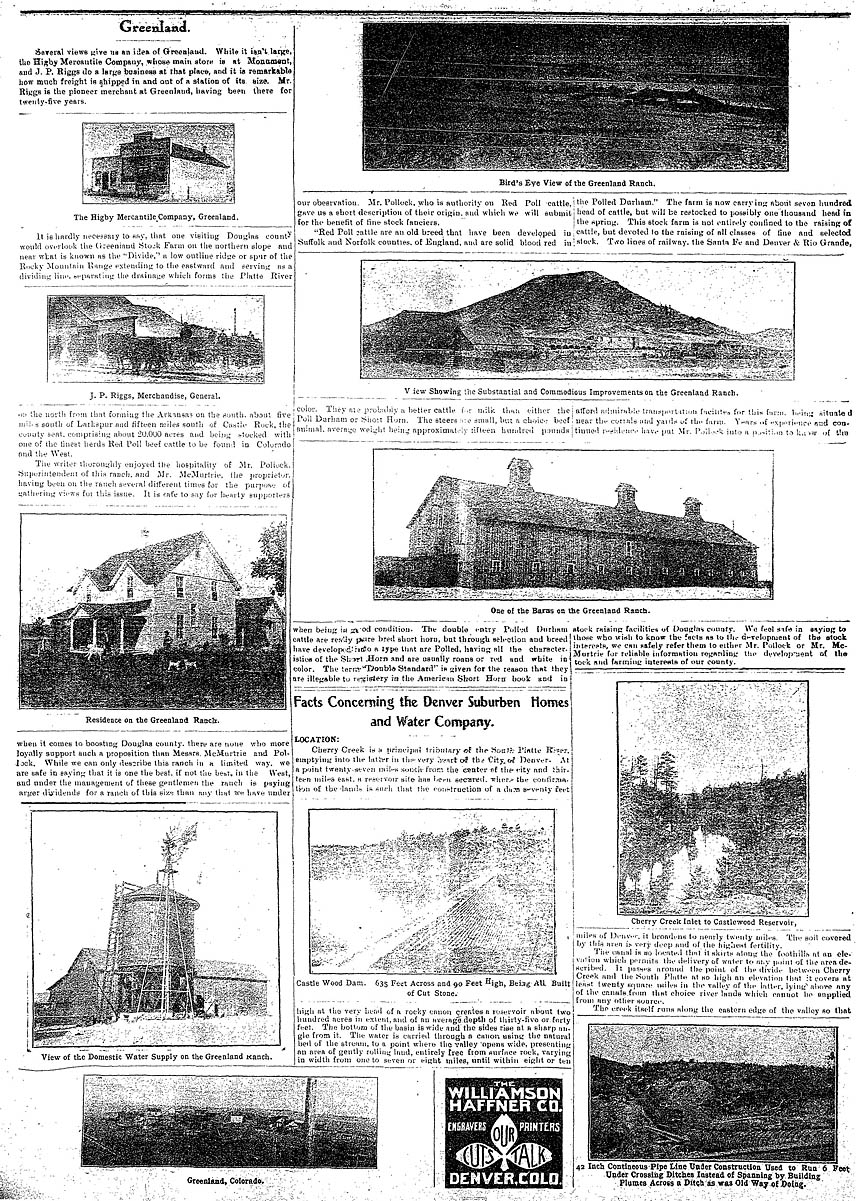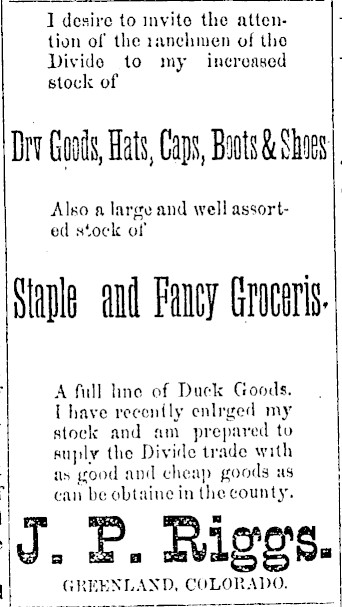Greenland Ranch Through the Years
|

Easily seen by travelers on Interstate 25 between Castle Rock and Colorado Springs for decades, the Greenland Ranch barn, built in 1922 was a state landmark. 2004 and 2023 views show the "before and after" results of a lightning strike during one of the massive thunder storms in May. The barn had survived many fires through the years, but finally burned at 3:30AM on May 11, 2023 according to TV reports. Ironically, it's 1887 predecessor was destroyed by fire, also started by a lightning strike in 1922 just over 100 years ago.
April 25, 1883, The Castle Rock Journal
From Greenland's icy mountains,
From Larkspur's verdant strand,
Where Plum creek's sunny fountains
Roll down their golden sand;
From many a ranch and hamlet,
From many a grassy plain,
Our hymn of thanks is rising
Through mingled snow and rain.
April 8, 1898, The Castle Rock Journal
A herd of 700 cattle were driven through town Monday morning on their way to Greenland ranch.
March 18, 1899, The West Creek Mining News
Miss McMurtrie, daughter of the late John Alen McMurtrie of Denver, announces that she will continue the business of raising Shorthorn cattle at the Greenland ranch. This immense tract of 16,400 acres is located in Douglas county, and on it are $35,000 worth of as good cattle as can be found in the state Miss McMurtrie who is administratrix of her deceased father’s estate, asked the courts leave to set certain stocks and bonds, but prefered to hold on to the best income property in the entire inventory of assets. She today is the cattle queen of Colorado.
June 12, 1958, The Douglas County News
CARD OF THANKS The Higbys want to thank the members of the Castle Rock and Palmer Lake Fire Departments, John Hammond, our neighbors, Louis Anderson and all others that helped extinguish the fire at the Greenland Ranch on Wednesday, for their help.
The extent of damage was lessened considerably by the promptness and efficient action of the fire departments. It is very gratifying to know that help can be obtained so quickly. - Greenland Cattle Company.
September 27, 1988, Douglas County News-Press
Larkspur firefighters busy over weekend
Larkspur firefighters spent six hours Saturday battling several large grass fires around the Greenland Ranch area.
Fire Chief Pete Dunckel reported that one vounteer firefighter suffered from smoke inhalation but was treated by paramedics and released Saturday evening.
"We had a total of about six fires, all of which seem to have been started by the trains," Dunckel said. "We put the first five ones out pretty quickly, but the last one was the biggest."
Dunckel said the largest fire burned around 35 acres of dry prairie grass just north of Greenland and was extinguished by about 30 firefighters from Larkspur, Palmer Lake, and Tri-Lake fire departments. Dunckel said the fires likely were started from hot axle bearings.
"The railroad company sprays to kill the weeds around the tracks, but some of the hot cinders can blow 15 feet or more into dry grass." Dunckel said all fires were extinguished or under control by late afternoon, and there were no structures damaged.
|


1883 Ad for J.P. Riggs and his general merchandise store in Greenland, Colorado. From Colorado Historic Newspapers Collection.
|
January 3, 1908, The Castle Rock Journal
Greenland
"Several views give us an idea of Greenland. While it isn't large, the Higby Mercantile Company, whose main store is at Monument, and J.P. Riggs do a large business at that place, and it is remarkable how much freight is shipped in and out of a station of its size. Mr. Riggs is the pioneer merchant at Greenland, having been there for twenty-five years.
It is hardly necessary to say, that one visiting Douglas county would overlook the Greenland Stock Farm on the northern slope and near what is known as the "Divide," a low outline ridge or spur of the Rocky Mountain Range extending to the eastward and serving as a dividing line, separating the drainage which forms the Platte River on the north from that forming the Arkansas on the south, about five miles south of Larkspur and fifteen miles south of Castle Rock, the county seat, comprising about 20,000 acres and being stocked with one of the finest herds Red Poll beef cattle to be found in Colorado and the West.
The writer thoroughly enjoyed the hospitality of Mr. Pollock, Superintendant of this ranch, and Mr. McMurtrie, the proprietor, having been on the ranch several different times for the purpose of gathering views for this issue. It is safe to say for hearty supporters when it comes to boosting Douglas county, there are none who more loyally support such a proposition than Messrs. McMurtrie and Pollock. While we can only describe this ranch in a limited way, we are safe in saying that it is one the best, if not the best, in the West, and under the management of these gentlemen the ranch is paying larger dividends for a ranch of this size than any that we have under our observation, Mr. Pollock, who is authority on Red Poll Cattle, gave us a short description of their origin, and which we will submit for the benefit of fine stock fanciers.
Red Poll cattle are an old breed that have been developed in Suffolk and Norfolk counties, of England, and are solid blood red color. They are probably a better cattle for milk than either the Poll Durham or Short Horn. The steers are small, but a choice beef animal, average weight being approximately fifteen hundred pounds when being in good condition.
The double entry Polled Durham cattle are really pure bred short horn, but through selection and breed have developed into a type that are Polled, having all the characteristics of the Short Horn and are usually roans or red and white in color. The term "Double Standard" is given for the reason that they are illegible to registry in the American Short Horn book and in the Polled Durham. The farm is now carrying about seven hundred head of cattle, but will be restocked to possibly one thousand head in the spring. This stock farm is not entirely confined to the raising of cattle, but devoted to the raising of all classes of fine and selected stock.
Two lines of railway, the Santa Fe and Denver & Rio Grande, afford admirable transportation facilities for this farm, being situated near the corral and yards of the farm. Years of experience and continued residence have put Mr. Pollock into a position to know of the stock raising facilities of Douglas county. We feel safe in saying to those who wish to know the facts as to the development of the stock interests, we can safely refer them to either Mr. Pollock or Mr. McMurtrie for reliable information regarding the development of the stock and farming interests of our county."
From Colorado Historic Newspapers Collection. |

Early 1900s view looking west of the Greenland Ranch with the original barn built in 1887. Ironically, in July of 1922, the barn was struck by lightning and burned to the ground delaying all train traffic for several hours because of the intense heat. The new barn was built later that same year.
Photo and following text from the Larkspur Historical Society
Greenland Ranch History
The magnificent red barn, seen from I-25, is a well known landmark for the famous Greenland Ranch. The ranch lands were homesteaded during the years of 1870 to 1875 assembled in the early 1880s and became known as the Greenland Breeding Farm. The original barn, built in 1887 by the Union Real Estate and Livestock Investment Company, was larger than the existing one today. Its dimensions were 36x101 feet and the barn contained 18 box stalls, capable of accommodating over 100 head of the best thoroughbreds. The hay loft had a capacity of 110 tons of hay. A Covered area on the west side of the barn stored buggies and spring wagons. In July of 1922, the barn was struck by lightening and burned to the ground delaying all train traffic for several hours because of the intense heat. The new barn, built by Jim Oker of Elbert, was erected later that same year and is 25 feet shorter than the first building.
I.J. Noe (Isaac Jegirtha Noe) came to the Greenland area from Indiana in 1878 and was superintendent of the Greenland Breeding Farm operations for many years. In addition he helped to assemble the original ranch by purchasing homesteads and then selling them back to the incorporators. In 1890 Mr. Noe founded the Eagle Mountain Ranch, located one and one half miles west of the Greenland Ranch and is still run by members of his family. I.J. married Jennie Cain and they had two children Charles Fred and Gertrude. Mr. Noe’s brand is the oldest brand in Colorado and he was well known for his shorthorn cattle.
Cattle ranches were divided into districts with Douglas County and the Greenland Ranch assigned as District 8. The ranch, lying between the Denver & Rio Grande and Atchison Topeka and Santa Fe Railroad tracks meant thousands of animals were rounded up and driven to Greenland for transport to market in the fall. Roundups were easily done in those days as there were few fences and mostly open range. Greenland was one of the largest shipping points for livestock in the State of Colorado. The Greenland Ranch provided the holding pens as well as the wooden loading chutes, as can still be seen along the railroad siding. The ranch is stated to have the longest continuously operating cattle ranch in Colorado.
Greenland Breeding Farm was purchased in 1906 by John W. Higby and C.C. Hemming, an officer of the El Paso National Bank of Colorado Springs. The name was changed to Greenland Land and Cattle Company and was recognized all over the United States for its fine selection of Shorthorn, Galloway and Hereford cattle as well as thoroughbred horses. At one time the 15,000 plus acres grazed as many as 1,600 head of cattle and 500 horses as well as raising 7000 bushels of wheat, oats, rye, corn and barley. The ranch stayed in the Higby family until it was sold in 1980 to William E. Simon, U.S. Treasury Secretary, Bruce Shepard, a developer and the Oklahoma Publishing Company.
Greenland Ranch encapsulates one of the largest undeveloped tracts of land between Denver and Colorado Springs and more importantly, is virtually unchanged since its beginnings before the turn of the century. In 2000 Greenland Ranch was purchased by The Conservation Fund in a 5 way partnership with Great Outdoors Colorado (GOCO), Douglas County, Colorado Division of Wildlife, Colorado State Parks and John Malone, a local rancher. This beautiful landmark is now protected with conservation easements and a very limited development plan thereby protecting its original integrity perpetually. |
|











